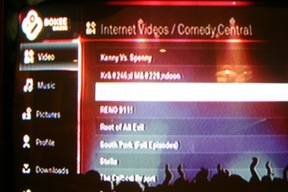|
Today's Opinions, Tomorrow's Reality
Slick, Easy, and Free By David G. Young Washington DC, January 27, 2009 -- Video streaming is the future of television. The cable television industry isn't going to like it. The future of television made an early appearance in my living room on Sunday night, when I got my first taste of real internet video on demand. Using software from a New York-based startup company called Boxee, I was able to use my remote control to select from thousands of television programs for immediate viewing. The system was slick, easy to use, and best of all, free. This is revolutionary. No more cable bills. No more watching programs on the network's schedule. No more fiddling with a VCR or Tivo to record shows for later. Just pick a show with your remote and watch it on your TV whenever you want.
But the revolution doesn't belong to Boxee. None of the technologies used in its system were invented by the company. The website Hulu.com debuted last year with a large collection of television shows and films that could be streamed to your computer. (Internet video streaming has been around for over a decade.) Hulu has since been joined by other web sites offering a fantastic variety of popular and niche programs for free -- albeit with short advertisements included. As great as they are, all of the existing online video services have real problems. They are built to stream videos to your computer (not your TV), and each has a different user interface. This makes finding and viewing shows on multiple services a clunky process that typically ends with the video playing on only a small window within your computer monitor. Boxee solves those problems with a "shell" program that provides a common user interface for multiple video services that is run by a television remote instead of a computer keyboard and a mouse. And with Boxee, videos are displayed in a full-screen format suitable for television. This may sound simple, but cobbling together these different systems is a surprisingly difficult task. Boxee has done an amazingly good job given that the company only has 11 employees1. Trouble is, Boxee's small size makes it particularly vulnerable to being crushed or co-opted by the cable TV companies that have the most to lose from the rise of on-demand internet TV systems. When such a systems take over, cable companies will become nothing more than second rate internet service providers. Why should consumers pay $50 per month for a low-end cable or satellite package when they can watch whatever they want whenever they want for free? Before long, the smarter folks among the 84 percent of American households that subscribe to cable2 and satellite services are going to realize this, and they'll start dropping their subscriptions. Given the billions of dollars at state, cable and satellite companies are likely to freak out in a way that makes the record industry's response to file sharing look tame by comparison. Fortunately for cable, internet video systems like Boxee aren't quite ready for everyone. Streaming video works great for recorded programs, but has not been as widely adopted for live events. Many sporting events will probably remain under the thumb of broadcasters, likely keeping die-hard fans shackled to their cable bills for years to come. And for the rest of us, there are the technical problems. Boxee's system may be the furthest along, but it hasn't even started its beta test. It's still in an early "alpha" testing program that is only being used by about 150,000 people worldwide.3 Want to try it on your TV? Good luck: You'll need your own Macintosh or Linux computer (preferably the rare kind with a remote control and the ability to connect to a television) and you have to be able to troubleshoot bleeding-edge software installations. (It took me all weekend to get a Linux set top computer working with Boxee, despite my professional software skills.) Even when set up, Boxee often freezes, and has more than enough glitches to warrant its "alpha" description. Given its current state, it may be a year or more before it's ready for the average consumer on a dedicated set-top box. Yet that day is rapidly approaching, and other companies are working to get in on the action. Vizio, a California-based flat panel television manufacturer, recently announced plans to produce a TV with a built-in WiFi receiver that can displays streaming internet video from Amazon Video on Demand, Netflix and other sources.4 Hopefully, these video on demand systems get enough traction and build enough support with big players from the production studios and Hulu (which is owned by NBC Universal and News Corp.) to overcome the inevitable resistance of the cable and satellite industry. Now that I've experienced the future of television, it's hard to imagine ever going back. Related Web Columns: Useful Lies The Fighting Power of Underground Video, May 24, 2005 Just Around the Corner Notes: 1. New York Times, Boxee, Used to View Web on TV, Generates Buzz, January 16, 2009 2. Gartner Research, Gartner Says Saturation of U.S. Pay-TV Market to Create Challenges for Emerging IPTV Services, October 1, 2007 3. Boxee Corporate Blog, Opening Up the Alpha, December 21, 2008 4. Vizio Press Release, Vizio Announces New and Exciting "Connected HDTV" Platform With Wireless Connectivity, January 7, 2009 |

